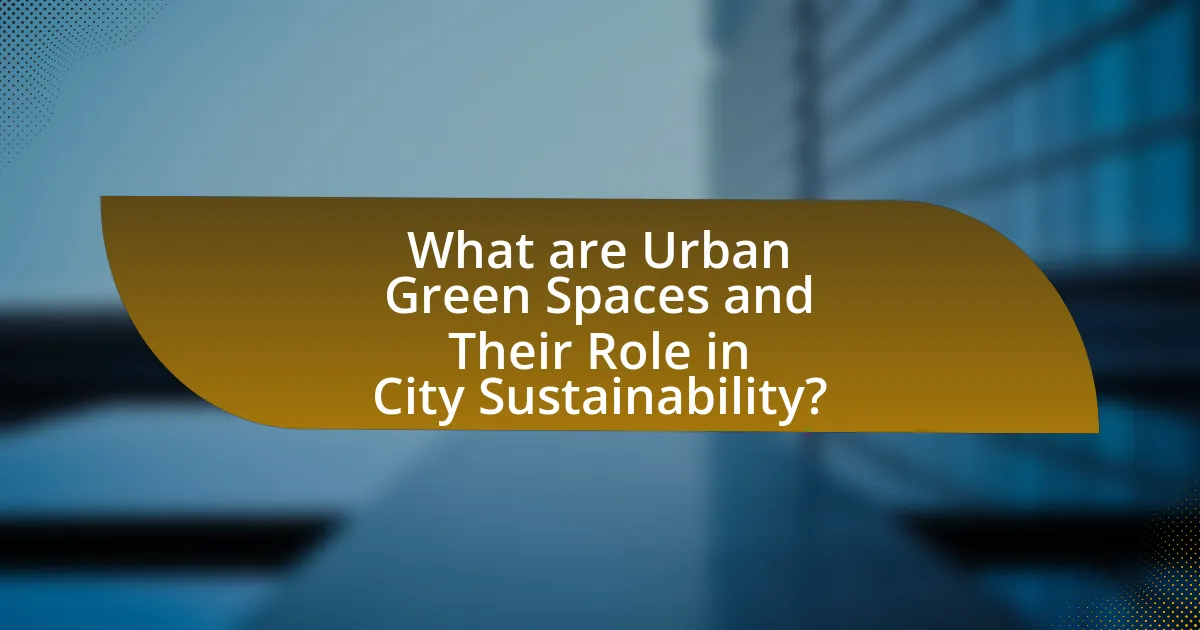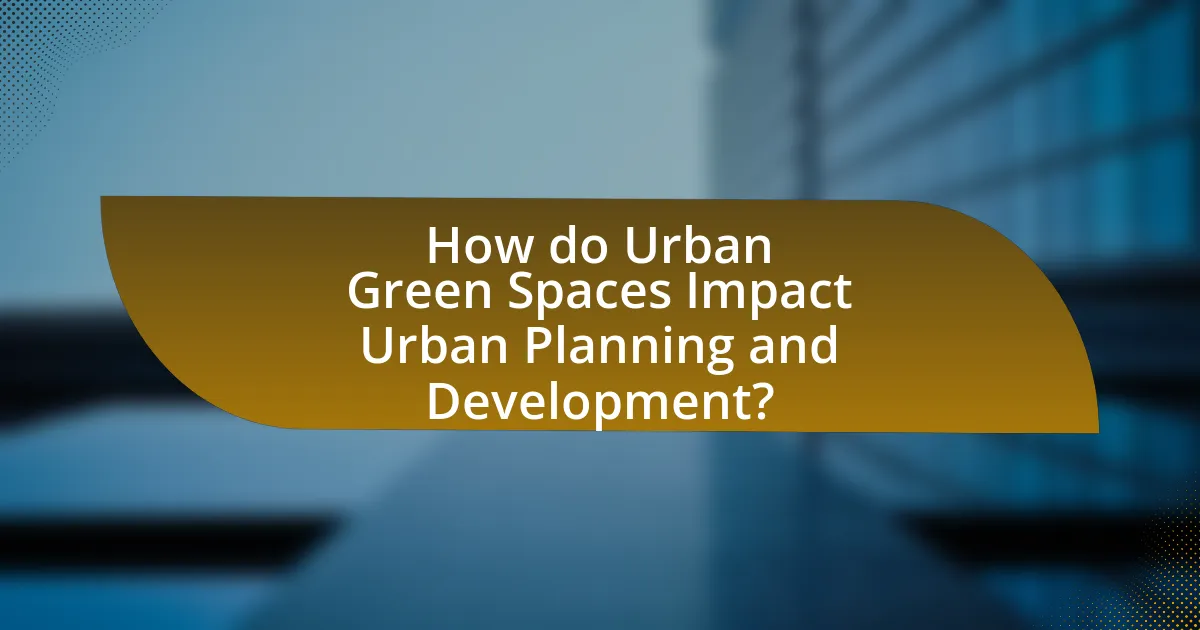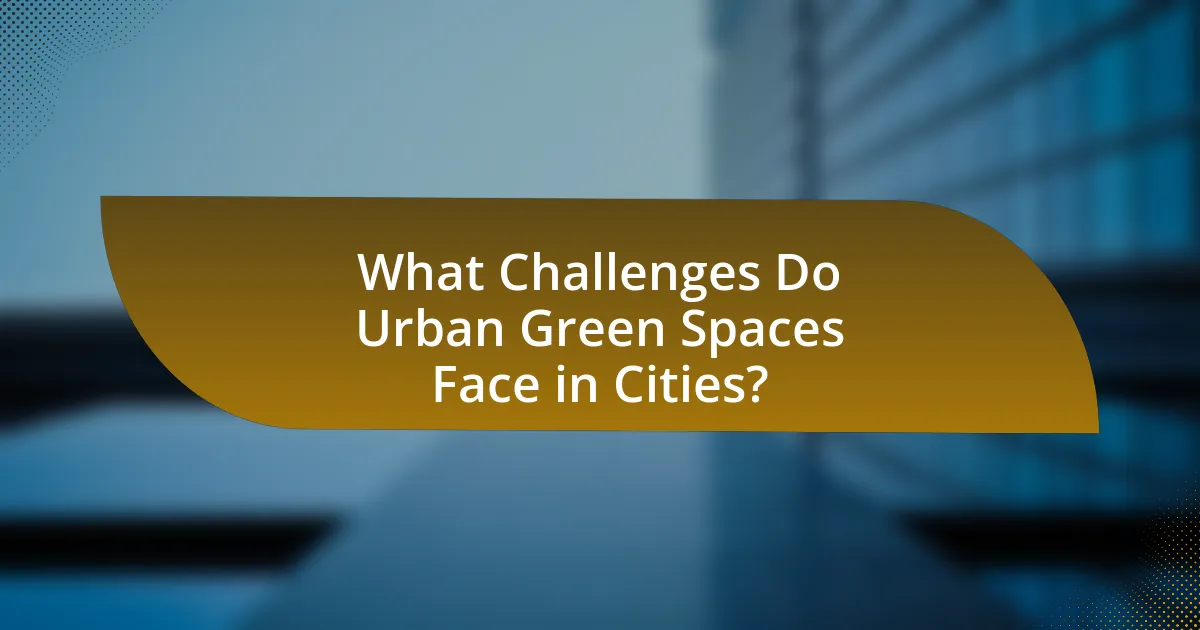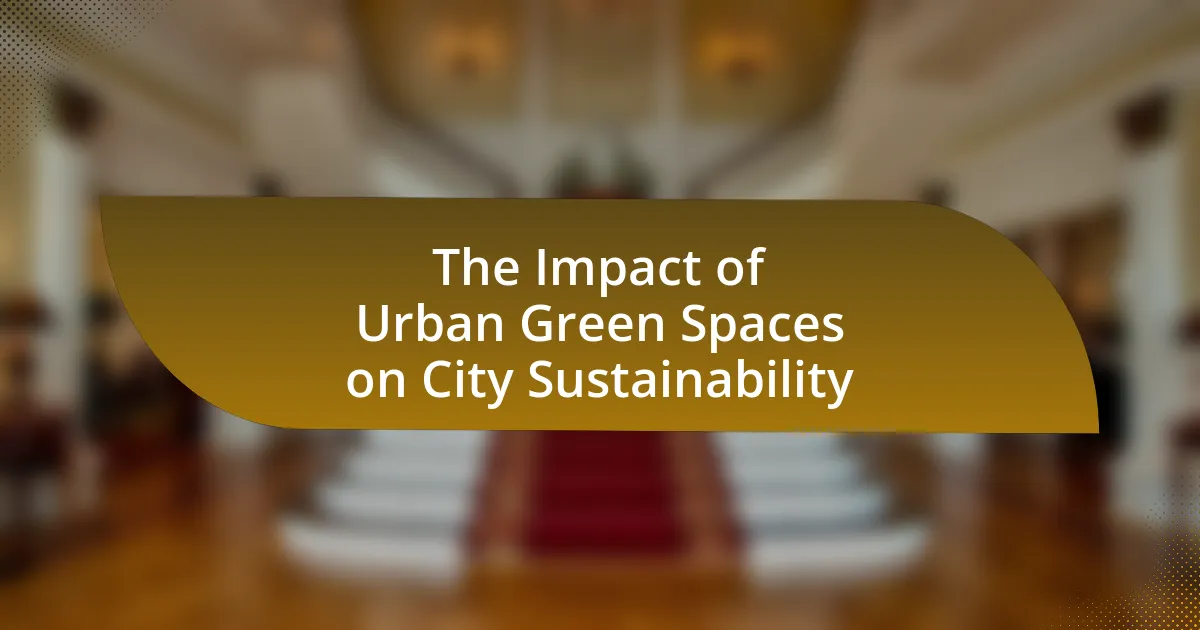Urban green spaces, including parks, gardens, and green roofs, are essential components of city sustainability, contributing to environmental health, social well-being, and economic advantages. These spaces enhance biodiversity, improve air quality, and mitigate urban heat, while also promoting community interaction and mental health benefits. The article explores the specific environmental benefits of urban green spaces, their role in urban planning, and the challenges they face, such as funding and land use competition. Additionally, it discusses strategies for integrating and maintaining these spaces effectively to maximize their positive impact on urban environments.

What are Urban Green Spaces and Their Role in City Sustainability?
Urban green spaces are areas within urban environments that are dedicated to vegetation and natural landscapes, such as parks, gardens, and green roofs. These spaces play a crucial role in city sustainability by enhancing biodiversity, improving air quality, and providing recreational opportunities for residents. Research indicates that urban green spaces can reduce urban heat islands by lowering temperatures, which contributes to energy savings and mitigates climate change effects. Additionally, a study published in the journal “Environmental Science & Technology” found that urban greenery can absorb significant amounts of carbon dioxide, further supporting environmental sustainability.
How do Urban Green Spaces contribute to environmental health?
Urban green spaces significantly contribute to environmental health by improving air quality, enhancing biodiversity, and mitigating urban heat. These areas, such as parks and gardens, act as natural air filters, absorbing pollutants and releasing oxygen, which can lead to a reduction in respiratory diseases. Research indicates that urban vegetation can lower particulate matter levels by up to 30%, thereby directly benefiting public health. Additionally, green spaces support diverse ecosystems, providing habitats for various species, which helps maintain ecological balance. Furthermore, they play a crucial role in temperature regulation; studies show that urban areas with ample greenery can be up to 5 degrees cooler than those without, reducing heat-related health risks.
What specific environmental benefits do Urban Green Spaces provide?
Urban green spaces provide significant environmental benefits, including improved air quality, enhanced biodiversity, and reduced urban heat. These areas act as natural air filters, absorbing pollutants and carbon dioxide while releasing oxygen, which contributes to cleaner air. Research indicates that urban vegetation can reduce particulate matter by up to 30%, significantly improving respiratory health for city dwellers. Additionally, urban green spaces support various species, promoting biodiversity; for instance, parks can host over 100 different bird species, contributing to ecological balance. Furthermore, these spaces mitigate the urban heat island effect by providing shade and cooling through evapotranspiration, which can lower surrounding temperatures by as much as 5 degrees Celsius.
How do Urban Green Spaces improve air quality in cities?
Urban green spaces improve air quality in cities by absorbing pollutants and producing oxygen through photosynthesis. Trees and plants filter harmful particulates from the air, such as carbon dioxide, sulfur dioxide, and nitrogen oxides, effectively reducing urban smog. For instance, a study published in the journal “Environmental Science & Technology” found that urban trees can remove up to 1.7 million tons of air pollution annually in the United States alone. Additionally, green spaces contribute to lower temperatures, which can decrease the formation of ground-level ozone, a key component of smog.
Why are Urban Green Spaces important for social well-being?
Urban green spaces are crucial for social well-being because they promote community interaction, enhance mental health, and provide recreational opportunities. Research indicates that access to green spaces can reduce stress and anxiety levels, with a study published in the journal “Environmental Science & Technology” showing that individuals living near parks report higher life satisfaction and lower rates of depression. Furthermore, urban green areas serve as venues for social gatherings, fostering a sense of belonging and community cohesion, which is essential for overall social health.
How do Urban Green Spaces promote community interaction?
Urban green spaces promote community interaction by providing accessible venues for social gatherings, recreational activities, and community events. These spaces, such as parks and gardens, serve as focal points where residents can meet, engage in physical activities, and participate in organized events, fostering a sense of belonging and community cohesion. Research indicates that neighborhoods with ample green spaces report higher levels of social interaction and community engagement, as evidenced by a study published in the Journal of Urban Planning and Development, which found that parks significantly increase the frequency of social interactions among residents.
What mental health benefits are associated with Urban Green Spaces?
Urban green spaces provide significant mental health benefits, including reduced stress, improved mood, and enhanced cognitive function. Research indicates that exposure to nature can lower cortisol levels, which are associated with stress, and promote feelings of relaxation and well-being. A study published in the journal “Environmental Science & Technology” found that individuals living near green spaces reported lower levels of anxiety and depression. Additionally, green spaces encourage physical activity, which is linked to better mental health outcomes. The presence of parks and gardens fosters social interactions, further contributing to improved mental health by reducing feelings of isolation.
What economic advantages do Urban Green Spaces offer cities?
Urban green spaces provide significant economic advantages to cities by enhancing property values, attracting tourism, and reducing urban heat island effects. Studies indicate that properties near parks and green areas can see a value increase of 5% to 20%, as evidenced by research from the National Recreation and Park Association. Additionally, urban green spaces can boost local economies by attracting visitors; for instance, cities with well-maintained parks often report increased foot traffic and spending in nearby businesses. Furthermore, these spaces contribute to energy savings by mitigating heat, which can lower cooling costs for residents and businesses, thereby improving overall economic efficiency.
How do Urban Green Spaces influence property values?
Urban green spaces positively influence property values by enhancing the aesthetic appeal and livability of neighborhoods. Studies indicate that properties located near parks and green areas can see value increases ranging from 5% to 20%. For instance, a study published in the Journal of Environmental Management found that proximity to urban parks significantly boosts residential property prices, with a notable increase in demand for homes within a quarter-mile radius of such spaces. This correlation is attributed to the perceived benefits of green spaces, including improved air quality, recreational opportunities, and overall quality of life, which make these areas more desirable for potential buyers.
What role do Urban Green Spaces play in attracting tourism?
Urban green spaces significantly attract tourism by enhancing the aesthetic appeal and recreational opportunities of a city. These areas, such as parks and gardens, provide visitors with a natural environment that promotes relaxation and leisure activities, which are key factors in travel decisions. Research indicates that cities with abundant green spaces experience higher tourist footfall; for instance, a study by the University of Illinois found that urban parks can increase local tourism revenue by up to 20%. Additionally, green spaces often host cultural events and festivals, further drawing tourists and contributing to the local economy.

How do Urban Green Spaces Impact Urban Planning and Development?
Urban green spaces significantly influence urban planning and development by enhancing environmental quality, promoting social cohesion, and improving public health. These spaces contribute to biodiversity, reduce urban heat, and manage stormwater, which are critical factors in sustainable urban design. For instance, a study by the American Society of Landscape Architects found that urban parks can lower city temperatures by up to 5 degrees Fahrenheit, thereby mitigating the urban heat island effect. Additionally, green spaces foster community interaction and inclusivity, as evidenced by research from the University of Illinois, which indicates that neighborhoods with accessible parks report higher levels of social engagement. Furthermore, the presence of green areas is linked to improved mental and physical health outcomes, with studies showing that individuals living near parks have lower stress levels and higher physical activity rates. Thus, urban green spaces are essential components in the planning and development of sustainable cities.
What strategies can cities implement to integrate Urban Green Spaces?
Cities can implement strategies such as creating green corridors, enhancing park accessibility, and incorporating green roofs to integrate Urban Green Spaces effectively. Green corridors connect existing parks and natural areas, promoting biodiversity and providing wildlife habitats, as evidenced by studies showing increased species diversity in urban areas with connected green spaces. Enhancing park accessibility through improved public transportation and pedestrian pathways encourages community use, which has been linked to increased physical activity and mental well-being. Additionally, incorporating green roofs in urban architecture not only utilizes space efficiently but also contributes to energy savings and stormwater management, with research indicating that green roofs can reduce urban heat by up to 5 degrees Celsius. These strategies collectively enhance urban sustainability by improving air quality, reducing heat islands, and fostering community engagement.
How can zoning laws support the development of Urban Green Spaces?
Zoning laws can support the development of Urban Green Spaces by designating specific areas for parks, gardens, and green corridors within urban environments. These regulations can ensure that a certain percentage of land is allocated for green spaces, thereby promoting biodiversity and enhancing the quality of life for residents. For instance, cities like New York have implemented zoning regulations that require developers to include green roofs or open spaces in new constructions, which has led to an increase in urban greenery. Additionally, zoning laws can restrict the types of developments in certain areas to prevent encroachment on existing green spaces, thereby preserving them for public use and ecological benefits.
What are the best practices for designing Urban Green Spaces?
The best practices for designing urban green spaces include ensuring accessibility, incorporating native plant species, and integrating multifunctional uses. Accessibility is crucial as it allows diverse populations to engage with green spaces, promoting social interaction and physical activity. Research indicates that parks located within a 10-minute walk from residences significantly increase usage rates, enhancing community well-being.
Incorporating native plant species is essential for promoting biodiversity and reducing maintenance costs. Native plants are adapted to local climates and soil conditions, requiring less water and fewer chemical inputs. Studies show that urban areas with higher biodiversity in green spaces can better support wildlife and improve ecosystem services.
Integrating multifunctional uses, such as recreational areas, community gardens, and educational spaces, maximizes the utility of green spaces. This approach not only meets various community needs but also fosters environmental awareness and stewardship. Evidence from cities like New York and Singapore demonstrates that well-designed urban green spaces can significantly enhance urban sustainability by improving air quality, reducing heat island effects, and managing stormwater runoff effectively.
How do Urban Green Spaces affect urban biodiversity?
Urban green spaces enhance urban biodiversity by providing habitats for various species, including plants, insects, and wildlife. These areas serve as critical refuges that support ecological interactions and promote species richness. Research indicates that urban green spaces can increase local biodiversity by up to 30%, as they create microhabitats that facilitate the survival of different species in urban environments. For instance, a study published in “Landscape and Urban Planning” by Jim and Chen (2003) found that parks and green roofs significantly contribute to the diversity of urban flora and fauna, demonstrating the vital role these spaces play in sustaining ecological balance within cities.
What species benefit from the presence of Urban Green Spaces?
Urban green spaces benefit a variety of species, including birds, insects, mammals, and plants. These areas provide essential habitats and resources, such as food and shelter, which support biodiversity in urban environments. For instance, studies have shown that urban parks can host over 100 bird species, including songbirds and raptors, while also serving as critical habitats for pollinators like bees and butterflies. Additionally, urban green spaces contribute to the presence of small mammals, such as squirrels and raccoons, which thrive in these environments due to the availability of food and nesting sites. The presence of diverse plant species in these areas further enhances ecological resilience and supports various life forms, demonstrating the significant role urban green spaces play in sustaining urban biodiversity.
How can Urban Green Spaces serve as wildlife corridors?
Urban green spaces can serve as wildlife corridors by providing essential habitats and pathways for various species to navigate urban environments. These areas, such as parks, gardens, and green roofs, facilitate the movement of wildlife between fragmented habitats, thereby enhancing biodiversity. Research indicates that urban green spaces can support a range of species, including birds, insects, and small mammals, by offering food sources, shelter, and breeding sites. For example, a study published in the journal “Landscape and Urban Planning” found that urban parks significantly increase species richness and abundance, demonstrating their role as effective wildlife corridors in cities.

What Challenges Do Urban Green Spaces Face in Cities?
Urban green spaces face several significant challenges in cities, including land use competition, maintenance issues, and environmental stressors. Land use competition arises as urban areas prioritize development for housing and commercial purposes over green space, leading to reduced availability and accessibility of parks. Maintenance issues stem from insufficient funding and resources, resulting in neglected areas that can deter public use and diminish ecological benefits. Environmental stressors, such as pollution and climate change, further threaten the health and sustainability of these green spaces, impacting biodiversity and the overall effectiveness of urban ecosystems. These challenges collectively hinder the potential of urban green spaces to contribute to city sustainability.
What are the common barriers to creating Urban Green Spaces?
Common barriers to creating Urban Green Spaces include limited funding, land availability, and regulatory constraints. Limited funding often restricts the ability of municipalities to invest in green projects, as evidenced by a 2018 report from the National Recreation and Park Association, which highlighted that 70% of parks departments face budget constraints. Land availability is another significant barrier, particularly in densely populated urban areas where space is at a premium, leading to competition with other land uses. Regulatory constraints, such as zoning laws and property rights, can also hinder the development of green spaces, as local governments may prioritize commercial or residential development over public parks. These factors collectively impede the establishment and maintenance of Urban Green Spaces, affecting overall city sustainability.
How does funding impact the development of Urban Green Spaces?
Funding significantly impacts the development of Urban Green Spaces by determining the resources available for planning, implementation, and maintenance. Adequate funding allows for the design and construction of parks, gardens, and green corridors, which enhance urban biodiversity and improve air quality. For instance, a study by the National Recreation and Park Association found that cities with higher investment in green spaces report better community health outcomes and increased property values. Additionally, funding influences the ability to engage communities in the planning process, ensuring that green spaces meet local needs and preferences, which can lead to higher usage rates and long-term sustainability.
What role does public perception play in the establishment of Urban Green Spaces?
Public perception significantly influences the establishment of urban green spaces by shaping community priorities and funding decisions. When residents view green spaces as essential for quality of life, they are more likely to advocate for their development and support policies that allocate resources towards these areas. Research indicates that cities with strong public support for green initiatives often see increased investment; for example, a study by the American Society of Landscape Architects found that 70% of respondents believe parks and green spaces enhance community well-being. This demonstrates that positive public perception can lead to greater political will and financial backing for urban green projects, ultimately contributing to sustainable city development.
How can cities overcome challenges related to Urban Green Spaces?
Cities can overcome challenges related to Urban Green Spaces by implementing strategic planning, community engagement, and sustainable funding mechanisms. Strategic planning involves integrating green spaces into urban development plans, ensuring they are accessible and equitably distributed across neighborhoods. Community engagement is crucial, as involving residents in the design and maintenance of these spaces fosters a sense of ownership and encourages stewardship. Sustainable funding mechanisms, such as public-private partnerships and grants, can provide the necessary financial resources for the creation and upkeep of green spaces. For instance, cities like New York have successfully utilized public-private partnerships to enhance Central Park, demonstrating that collaborative funding can lead to improved urban green spaces.
What innovative solutions exist for enhancing Urban Green Spaces?
Innovative solutions for enhancing urban green spaces include vertical gardens, green roofs, and urban forestry initiatives. Vertical gardens utilize wall space to grow plants, improving air quality and aesthetics while maximizing limited ground area. Green roofs provide insulation and reduce urban heat, contributing to energy efficiency in buildings. Urban forestry initiatives focus on planting trees in urban areas, which can increase biodiversity, improve stormwater management, and enhance community well-being. Studies show that cities with more green spaces experience lower temperatures and improved mental health outcomes, reinforcing the importance of these innovative solutions in promoting sustainability.
How can community involvement improve Urban Green Space initiatives?
Community involvement can significantly enhance Urban Green Space initiatives by fostering local ownership and ensuring that the spaces meet the needs of residents. Engaging community members in the planning and maintenance of green spaces leads to increased usage and care for these areas, as people are more likely to take pride in spaces they helped create. Research indicates that neighborhoods with active community participation in green space projects report higher satisfaction and usage rates, as seen in the study “Community Engagement in Urban Green Spaces” by the University of California, which found that participatory design processes resulted in parks that better reflect community preferences and needs. This active involvement not only improves the quality and accessibility of urban green spaces but also strengthens community ties and promotes environmental stewardship.
What are the best practices for maintaining Urban Green Spaces?
The best practices for maintaining urban green spaces include regular maintenance, community involvement, and sustainable management techniques. Regular maintenance involves tasks such as mowing, pruning, and litter removal to ensure the spaces remain safe and aesthetically pleasing. Community involvement encourages local residents to participate in the upkeep and stewardship of these areas, fostering a sense of ownership and responsibility. Sustainable management techniques, such as using native plants and implementing efficient irrigation systems, help conserve resources and promote biodiversity. Research indicates that well-maintained urban green spaces can improve air quality, reduce urban heat, and enhance overall community well-being, thereby contributing to city sustainability.
